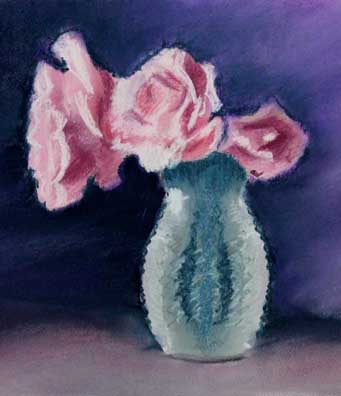Roses in Vase - Pastel

A new genre for CooperToons art. Not only is this a still life but it is sort of impressionistic.
Moi? Je suis impressioniste?
Well, not intentionally so, but that's just the way it came out.
That does kind of remind us of when the NBC news correspondent, Edwin Newman, was covering a story in Tunisia about President Bourgiba. He was about the leave the building where the president was appearing. An officer told him that if he left, he could not get back in.
"Mais, je suis journaliste," Edwin said.
"Oui, monsieur," replied the policeman courteously. "Et moi. Je suis policier."
Edwin stayed.
By the way, rendering this pastel drawing was instructive regarding dealing with still lifes which employed real plants and flowers. Once they became available, many still life set ups, particularly in arts classes, began using artificial flowers, fruits, and vegetables. And of course today an artist - even practicing professionals - will draw or paint from photographs they have previously taken. If you wander by an art class in an art center, art museum, or art school, it's not unusual to see a number of students drawing from their iPads or similar devices.
But as we said this still life was drawn from life and the flowers were real. But what is notorious is that in life drawing the models can move.
What? Sure, in life drawing of the human figure (and animals) the models can move. But flowers?
Well, yes. These roses were placed in a vase with water and under high intensity lights (artists like lots of shadows). So over the course of the class as the temperature began to increase, the flowers, particularly the center one, began to open up. The result was the center flower increased in size to where it was actually larger than the one on the left. It also shifted its position to where it was pointing more directly toward the viewer.
But of course at the beginning of the class the outlines of the vase and flowers were first sketched in. So what you are seeing is pretty much the way the set up looked at the beginning. What was instructive is that as the flowers shifted in size and orientation, the artist found himself having to extrapolate backwards to locate where the darker and lighter regions should be. An interesting exercise!